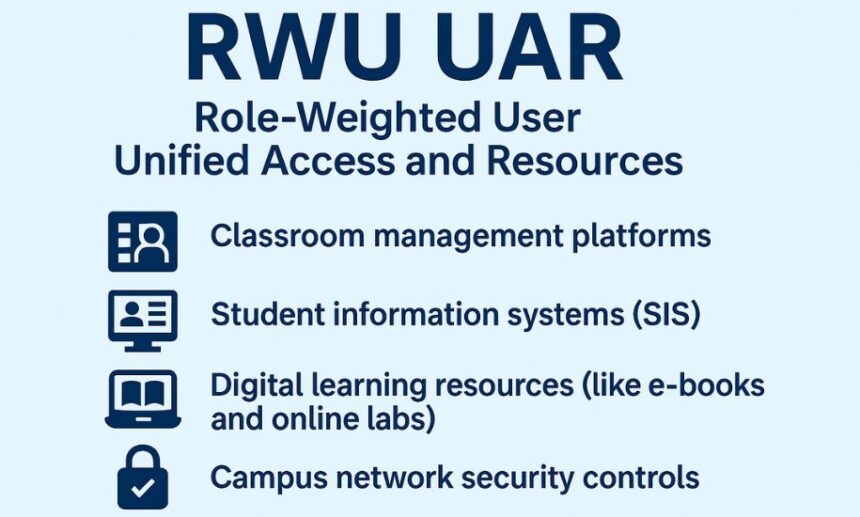In today’s digital-first classrooms, managing access to information and resources has become as important as teaching itself. Schools rely on cloud-based learning platforms, networked classrooms, and student information systems (SIS) to operate seamlessly. But with this digital shift comes a challenge: how do you ensure the right student, teacher, or staff member gets the right access at the right time—without overstepping privacy boundaries?
This is where RWU UAR—Role-Weighted User Unified Access and Resources—comes into play. Though not yet a standardized global acronym, it’s increasingly used by educational bloggers, IT consultants, and school administrators as shorthand for a framework that merges identity governance, role-based access control, and automated provisioning into one cohesive model.
RWU UAR isn’t just a buzzword; it captures the essence of what modern educational IT needs: seamless resource allocation, secure access reviews, and simplified digital operations.
Breaking Down the Acronym: RWU UAR Explained
R – Role-Weighted
“Role-weighted” highlights the heart of access management: permissions based on who you are and what role you play.
-
A teacher might need access to grading software, digital labs, and parent communication tools.
-
A student should only access their coursework, learning apps, and e-books.
-
IT administrators require elevated rights to oversee security, while counselors might need role-based access to student wellness records.
Weighting access by role prevents over-privilege—where users accidentally gain more access than they should, creating security gaps.
WU – User Unified
Schools often juggle dozens of platforms: Google Classroom, SIS databases, Clever portals, Microsoft Teams, campus Wi-Fi, and more. “User Unified” means one account, one login, one consistent identity across platforms. This approach reduces login fatigue, boosts security, and simplifies IT troubleshooting.
UAR – Unified Access and Resources
The “UAR” portion ties everything together. It refers to centralized access reviews, entitlement checks, and unified resource provisioning. Think of it as an umbrella ensuring students and staff always have what they need—but never more than they should.
In IT compliance, UAR often expands to User Access Review—a process where administrators regularly audit who has access to what. In schools, this ensures a graduated student doesn’t still have login access months later or that a substitute teacher only has temporary permissions.
Why RWU UAR Matters in Schools
-
Security & Privacy
Educational institutions manage highly sensitive data—grades, addresses, medical notes, and more. A framework like RWU UAR ensures data remains private while meeting compliance mandates (e.g., FERPA in the U.S.). -
Efficiency for Teachers & Students
Teachers lose precious time navigating multiple systems. RWU UAR simplifies access, so lesson prep, grading, and communication happen without friction. Students benefit from single sign-on (SSO) portals that instantly connect them to apps and resources. -
Scalability
Whether it’s onboarding thousands of new students at the start of a semester or provisioning accounts for staff, RWU UAR systems automate the heavy lifting. -
Audit & Accountability
With unified access reviews, schools can demonstrate compliance during audits, avoid penalties, and ensure only the right people handle sensitive data.
Where RWU UAR is Used
1. Classroom Management Platforms
Platforms like Google Classroom and Microsoft Teams for Education allow differentiated permissions. Teachers can control who posts, who edits, and who only views. Behind the scenes, this reflects RWU UAR principles—role-weighted, unified, resource-driven.
2. Student Information Systems (SIS)
Systems such as PowerSchool and Infinite Campus track enrollment, attendance, and grades. Integrated with RWU UAR, these platforms automatically sync user identities and assign access rights according to class rosters.
3. Digital Learning Resources
E-books, online labs, and publisher-provided platforms require precise access. With RWU UAR integration, students get immediate role-filtered access to only their assigned materials.
4. Campus Network Security
On the infrastructure side, network access control (NAC) systems like Cisco ISE or Aruba ClearPass enforce RWU UAR at the Wi-Fi level. Students, guests, and staff connect under different rules and bandwidth priorities.
How RWU UAR Works in Practice
Automated Provisioning
When a student enrolls, their SIS record triggers account creation across all learning apps, sets role-weighted permissions, and assigns required digital textbooks.
Access Reviews
Periodically, IT admins run a User Access Review. They check if any users still hold permissions they no longer need—say, a graduated senior still having access to campus servers.
Entitlement Management
Certain apps or labs may require special entitlements (e.g., chemistry software with licensing restrictions). RWU UAR frameworks ensure only eligible users get those entitlements, tracked automatically.
Role-Based Resource Allocation
Teachers logging into portals see lesson-planning tools. Principals see analytics dashboards. Students see coursework and e-library resources. Each login reflects the role, weighted for responsibilities.
Real-World Examples
-
Google Workspace for Education
Admins can set temporary elevated access for IT staff, create granular sharing controls, and enforce data loss prevention policies—all role-weighted access measures. -
Microsoft Education A5 Licenses
These bundles include access reviews and entitlement management, aligning with the UAR portion of the acronym. -
ClassLink & Clever
Both platforms unify access for students and staff across thousands of apps, leveraging roster-driven provisioning and SSO. -
Network Access Control in Schools
Aruba ClearPass and Cisco ISE provide differentiated campus Wi-Fi experiences—an application of RWU UAR in physical infrastructure.
Challenges in Implementing RWU UAR
-
Cost & Budgeting: Smaller schools may find it difficult to invest in enterprise-grade IAM solutions.
-
Training Needs: Teachers and administrators require orientation to use portals effectively.
-
Integration Gaps: Not all publishers’ resources sync smoothly with SIS or SSO frameworks.
-
Policy Updates: Role definitions may shift—what a “teacher” can access today may change tomorrow.
The Future of RWU UAR in Education
Looking ahead, RWU UAR principles will likely merge with AI-driven identity governance. Imagine predictive systems that:
-
Flag suspicious access in real time (e.g., a student logging in from an unusual location).
-
Automatically revoke unnecessary entitlements.
-
Recommend optimized resource allocation based on learning analytics.
Blockchain-based identity systems may also complement RWU UAR, giving students portable, verifiable credentials as they move between schools.
Conclusion: The Power of Unified Access
RWU UAR might not yet appear in every education technology handbook, but the ideas it represents—role-based access, unified identities, automated provisioning, and access reviews—are central to safe, efficient digital learning environments.
For teachers, it means less time logging in and more time teaching. For students, it ensures fairness and seamless access. For administrators, it ensures compliance and control.
As schools continue digitizing, RWU UAR will become a guiding framework for balancing security, privacy, and usability.
And if you’d like to explore more deep dives on technology, education, and innovation, visit Tumblr Magazine—a space where ideas meet insights.







